Play
Play
Play
Play
Play
Play
Play
Play
Previous
Next
GUIDES
Click here for the Installation Guide Video
Click here for a Powermax® 45XP Cut Charts
Click here for a Hypertherm® 68/85/105 Reference Guide
Click here for a Hypertherm® Inspection Chart
GENERAL
Protect your investment! Choose genuine torches and consumables for your Hypertherm® plasma cutting system and keep your system running at peak performance. Here’s why:
Patented technologies – Every day, Hypertherm® engineers are working on new ways to improve the plasma cutting process. Thousands of hours of engineering time focused solely on plasma consumable technology guarantees the best possible cutting performance from your system.
Synergistic design – Hypertherm® systems and consumables are designed to work together. System features and consumable designs are matched to optimize performance and reliability – to give you the best possible cut, over the longest service life.
Critical to function engineering – Hypertherm® engineers identify the critical features of each consumable part that will have an impact on cutting performance, and design accordingly. The specifications for these features are held to tolerance ranges that exceed even Six-Sigma quality standards.
Highest quality – Investments in the most current quality systems, state-of-the-art manufacturing facilities and intensive machine operator training ensure that every consumable part that you receive from us will perform to your highest expectations.
The main function of the shield is to protect and cool the other consumables, especially the nozzle from molten splatter. In some cases, the shield also contributes to the swirling action of the plasma gas.
COUNTERFEITS
Five reasons you should always buy genuine products through authorized distributors and avoid counterfeit products:
- Quality
Counterfeit suppliers have one thought in mind: a quick profit. They use the lowest cost materials and the cheapest, fastest production techniques; no stringent manufacturing processes, and no quality control. Their products are inferior, inconsistent, and unreliable. - Performance
Plasma torches are precision devices requiring precision consumables. Any deviation from specified tolerances may impact overall performance. Result: poor or inconsistent cuts, reduced cutting speed, and significantly shorter consumable life. Or even a ruined or damaged torch. - Safety
The low quality metals used in counterfeit manufacturing may not be able to withstand the thermal demands of plasma cutting, putting equipment and, more importantly, may put operators at risk. - Aftersales support
If unknown parts have been used in a damaged torch or plasma system, it will make troubleshooting difficult, if not impossible. The use of unauthorized parts may also affect your warranty coverage. - Overall operating costs
Those “low cost” counterfeit consumables can be a lot more expensive than they look. For starters, they do not last as long as genuine parts — often only a fraction of the cutting life. Poor quality cuts may require costly rework, and valuable equipment could be irreparably damaged. There’s also downtime to consider, not to mention the risk to your business or your brand.
HOW LONG WILL CONSUMABLES LAST?
Answered by Jim Colt, Strategic Account Manager at Hypertherm®
It’s hard to give an exact (or even in-exact) number as so many factors impact consumable life—operator experience, type and age of the torch, material type and thickness, air quality, etc. However, if the operator understands good piercing and edge starting techniques to keep molten metal from blowing back onto the torch nozzle (or tip if a non-Hypertherm system) then consumable life can be extremely good.
The biggest problem with most plasma torches occurs when hand cutting with an exposed (unshielded) nozzle. Ideally, you need to hold a standoff with an unshielded setup at all amperages greater than 30 amps or so. If the nozzle touches the plate during a cut it creates a current path between the negative electrode, nozzle, and positive plate. This causes a double arc between the electrode and nozzle, and the nozzle and plate, which damages the nozzle orifice. When the orifice gets a little damaged, poor angularity is the first thing you’ll notice, followed by more double arcs and more damage. Eventually you’ll notice slower cut speeds and heavy dross, at which point you’ll likely change your nozzle.
Some people use a standoff device to hold the torch up off the metal. Unfortunately, molten metal can still blowback during piercing, once again creating a current path from the nozzle to the plate and leading to double arcing. If you have used a hand held torch with an exposed nozzle at more than 30 amps while drag cutting, you’ve likely felt the torch “sticking” to the plate. This is a result of double arcing.
One way around this problem is through the use of shielded torch technology, invented and patented by Hypertherm® in the 80’s. The shield works to electrically isolate the nozzle from the plate to totally eliminate double arcing. Hypertherm® shielded torches drag cut at up to 200 amps with no friction or double arcing for a dramatic improvement in consumable life and cut quality.
In the 30 or so years since Hypertherm® introduced shielded torch technology, engineers have made enormous strides in the life of these consumables. For example, our Duramax® torches which come standard with nearly all new Powermax® systems and as a retrofit torch for most older Hypertherm® systems use the shield for more than just nozzle isolation. The shield and nozzle for these torches use patented technology called Conical Flow to inject greater air flow around the perimeter of the arc. This increases the energy density of the arc and provides better cooling to the nozzle. The result is no sticking, no double arcing, faster cut speeds, thicker piercing capability, and dramatically longer nozzle life.
So, assuming you are using a Duramax® torch with the latest consumable technology, then I would expect you to cut hundreds of feet of metal. In addition, you should be able to make between 600 and 1,200 pierces, after which time you would need to replace your electrode. Your remaining consumables would likely continue to work just fine. Put another way, you should be able to get between 2 and 4 full days of actual arc-on time before needing to replace any of your consumables.
TROUBLESHOOTING
SYMPTOMS 1
SYMPTOMS 2
TROUBLESHOOTING
One of the most common and frustrating problems in plasma-arc cutting (PAC) is short service life of parts. This problem hurts the fabricator both in increased consumable expense and in machine downtime for changing parts and troubleshooting. Most companies keep some record of parts life based on pierce counts, arc-on time, or the number of plates processed. The operator is usually the first to know when parts aren’t lasting as expected. Here are some technical tips to help the operator or maintenance troubleshoot a service life problem.
WARNING! Read all safety information in your operations manual before operating or repairing PAC equipment. PAC systems use high voltage and direct current (DC) electricity. Electric shock can injure or kill.
SYMPTOMS 1
SYMPTOM
The electrode and nozzle fail prematurely, causing a deterioration in cut quality, failure to pierce, or sudden loss of arc in the middle of a cut.
BACKGROUND
The electrode carries the negative DC charge from the power supply. It is comprised of a copper holder that contains an emissive element of hafnium or tungsten— metals with high melting points that will sustain an arc. The emitting element is slowly eroded away by the heat of the arc, and the high velocity plasma gas stream. During normal wear a small concave pit is formed in the end of the part which steadily wears away, a few thousandths of an inch at a time, to a depth of 0 .040 to 0.125 in. When the pit becomes too deep, the arc attaches to the copper holder and melts it. The electrode “fails” when it will no longer initiate and sustain an arc. It is a good practice to remove the electrode before it fails.
The nozzle focuses the plasma jet. The hole in the nozzle should be perfectly round and concentric. Both the diameter and length of the hole are critical: any damage to the orifice will affect the shape of the arc and, therefore, the quality of the cut piece. The plasma arc passes through the nozzle without contacting the copper material because the walls of the nozzle are protected by a boundary layer of swirling gas. If the arc does contact the nozzle it will melt some material away. Normal wear for a nozzle is slight chamfering or enlarging of the hole on the leading edge of the orifice. Some damage occurs to the face of the part during each pilot, causing heat discoloration around the orifice. Deposits of hafnium oxide can build up on the interior surface causing disruption of gas flow. The nozzle “fails” when it will no longer produce a straight arc and a good clean cut.
Normal parts life for state-of-the-art air and oxygen plasma systems is 1-2 hours of arc-on time and several hundred pierces. Some systems can reach 1,000 or more starts before a parts change is necessary.
TROUBLESHOOTING
The first step in solving any parts life problem is to examine the parts thoroughly and determine which part failed. The parts usually provide visible clues to the root cause of failure.
3 POSSIBLE CASES:
Case 1: Electrode bad and nozzle bad
If inspection of the parts’ service reveals that both electrode and nozzle are severely worn, it is likely that the electrode caused failure of the nozzle. Since the electrode is upstream, it will cause damage to the nozzle when molten material is blown out of the end of the part and deposited into the nozzle interior. If run long enough, all parts will fail in this way.
If the electrode has a deep wide pit and the copper has turned straw colored, blue, or black from overheating, the likely cause is low coolant flow. In extreme cases the end of the electrode may be melted away. Verify the flow rate of the cooling medium. In water-cooled torches check the cooling water flow rate with a bucket test at the return to the coolant tank. If it is not to spec, check for pump problems, kinks, leaks, plugged filters, or other restrictions. In gas cooled torches check for low gas flow.
Small pock marks all over the end of the electrode with corresponding damage to the interior of the nozzle indicates low gas flow. Low gas flow allows uncontrolled arcing between the nozzle and electrode. Check the gas flow rates to the torch. The best way to do this is with a flowmeter (0- 400 cfh) and hose placed on the outlet of the torch with the system in test. If not available, a quick check is to feel the gas flow at the outlet of the torch with only plasma gas turned on. You should feel a swirling flow of gas that actually has a suction force.
If the electrode has a heavy layer of black residue, check for gas contamination. One quick check is the paper towel test. Hold a clean paper towel under the torch with gas flowing through the system. There should be no sign of moisture or contamination.
Case 2: Electrode good and nozzle bad
If the electrode appears virtually new and the nozzle is severely damaged, the most likely cause of failure is double arcing of the nozzle. This occurs if the arc contacts the nozzle and erodes copper material from the orifice.
Damage to the interior of the nozzle such as a slot or “keyhole” indicates low pressure in the plasma chamber. This allows the arc to attach to the nozzle. Check for leaks in the gas lines by pressurizing the lines and using soapy water on all fittings.
Damage to the exterior of the nozzle often indicates a problem with torch-to- work distance. First check the pierce height; it should be two times the cut height to avoid metal spatter. Piercing too low is the number one cause of premature nozzle failure. Check for proper operation of the torch height control. If the torch pierces when it is pushed against the plate, or scrapes the plate during a cut, the nozzle will be instantly destroyed.
If the nozzle looks extremely hot, straw colored, blue-or black in color, check the shield gas flow. The shield gas helps to cool the nozzle and protect the front end of the torch.
Case 3: Electrode bad and nozzle good
If the nozzle is in good condition but the electrode has a deep concentric pit, the plasma gas flow rate may be too high. When the plasma gas swirl is too intense, the element erodes quickly. This causes a rapid deep wear pattern. Check the volumetric flow rate of the plasma gas.
A fourth case also exists: if both parts look virtually new but the torch failed to “fire,” and a new set allows the torch to start, the problem is not parts life; it’s hard starting. Often, perfectly good electrodes and nozzles are discarded because they failed to fire. Hard starting is most often caused by excessive plasma pressure during preflow when the torch is igniting. Usually the torch “spits and sputters” and struggles to start.
SYMPTOMS 2
Your torch does not fire.
You pull the trigger and…nothing. If this happens to you there are a couple of likely culprits. The first culprit is the retaining cap. It may be screwed on too tightly. The solution? Loosen it. See, we told you this was easy! If that doesn’t fix the problem, then there could be something wrong with the consumables inside your torch. You could have loaded the wrong ones or assembled the parts in the wrong order. Remove the consumables from your torch, take everything apart, and carefully reassemble, making sure to match all the part numbers with the numbers shown on the top of the machine. If your torch still doesn’t fire, then it’s probably time to place a call to our technical service team, but before you do that, there is one last thing you can do; try plugging in and using another torch. This likely won’t fix your problem but it will help our technical service team more quickly diagnose the issue.
You’re using a lot more consumables.
Hypertherm® invests a lot in engineering, includes a lot of patented technology, and very carefully machines our parts to very tight tolerances to ensure long life. Here’s the thing though, many factors impact the life you’ll get. Type and thickness of material being cut, number of holes and pierces you make, size of parts, etc. Still, if you are doing the same type of cutting and notice consumables which used to last for 1 to 2 hours are suddenly spent after only half that time, it’s safe to say, something is wrong.
Here are some things to consider. Look at your nozzle. Are you using a drag cutting or regular nozzle? If a drag cutting nozzle, are you keeping the nozzle on the metal for the entire duration of the cut? Check your incoming air supply as a sudden drop in life could mean moisture is getting into your incoming air supply. Make sure you are using genuine consumables manufactured by Hypertherm® and not an aftermarket supplier without access to our patented technologies, or worse, a counterfeiter. Counterfeiters have gotten so good at copying our consumable packaging; it’s incredibly difficult to tell the difference between genuine and non-genuine consumables. Protect yourself by (a) only buying from authorized Hypertherm® partners, and (b) avoiding retailers with prices that seem too good to be true.
Your system isn’t cutting like it used to.
Some change in cut quality is expected. For example, minor changes to edge angularity or the amount of dross you are seeing is quite common. But if your cut quality is suddenly markedly worse, here are some things to try. Change out your nozzle and electrode as those two consumable parts are often the first to show signs of wear. If that still doesn’t fix the problem, try changing your swirl ring. Also, look at your air supply as moisture could be the culprit here as well.
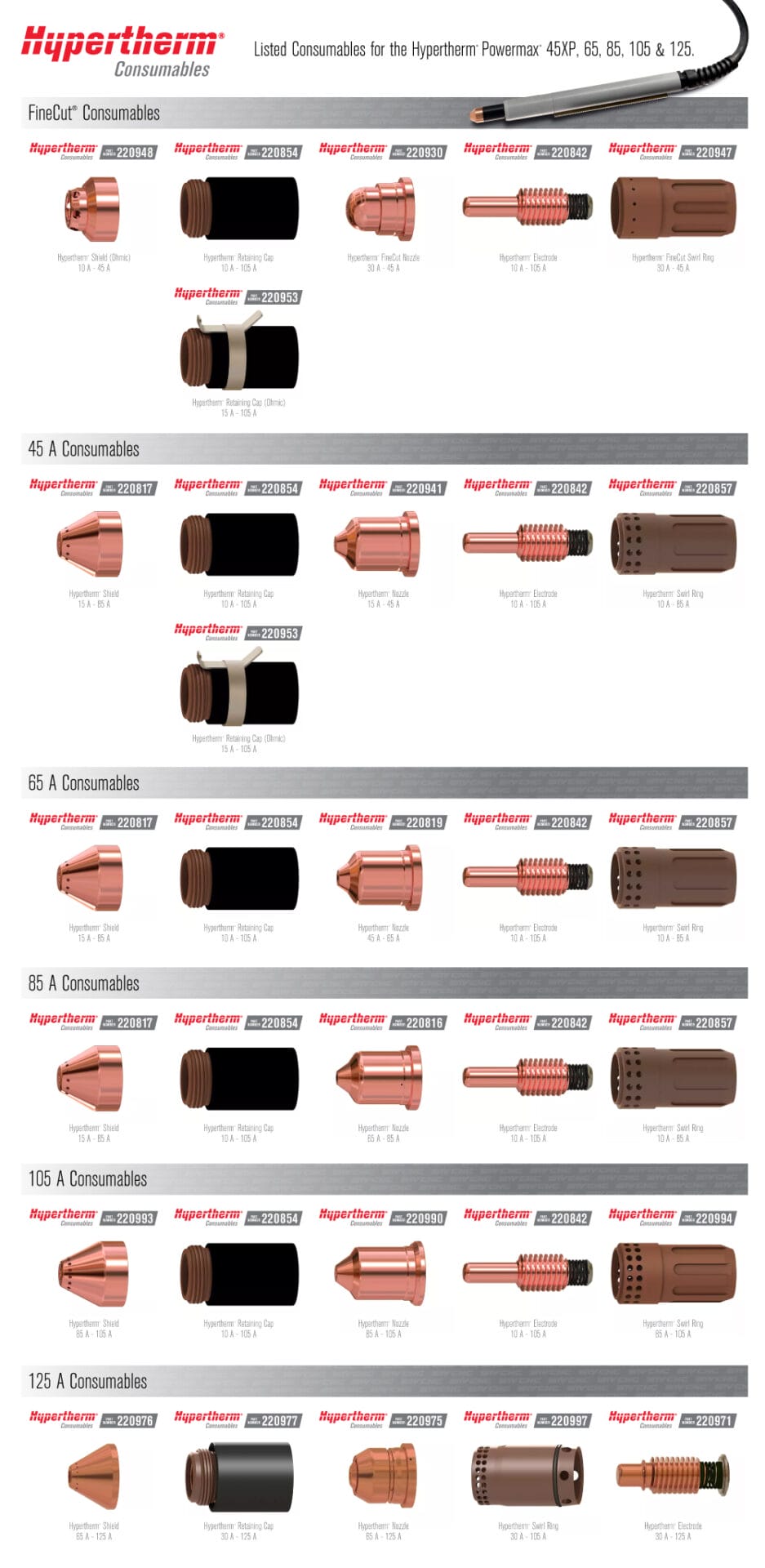
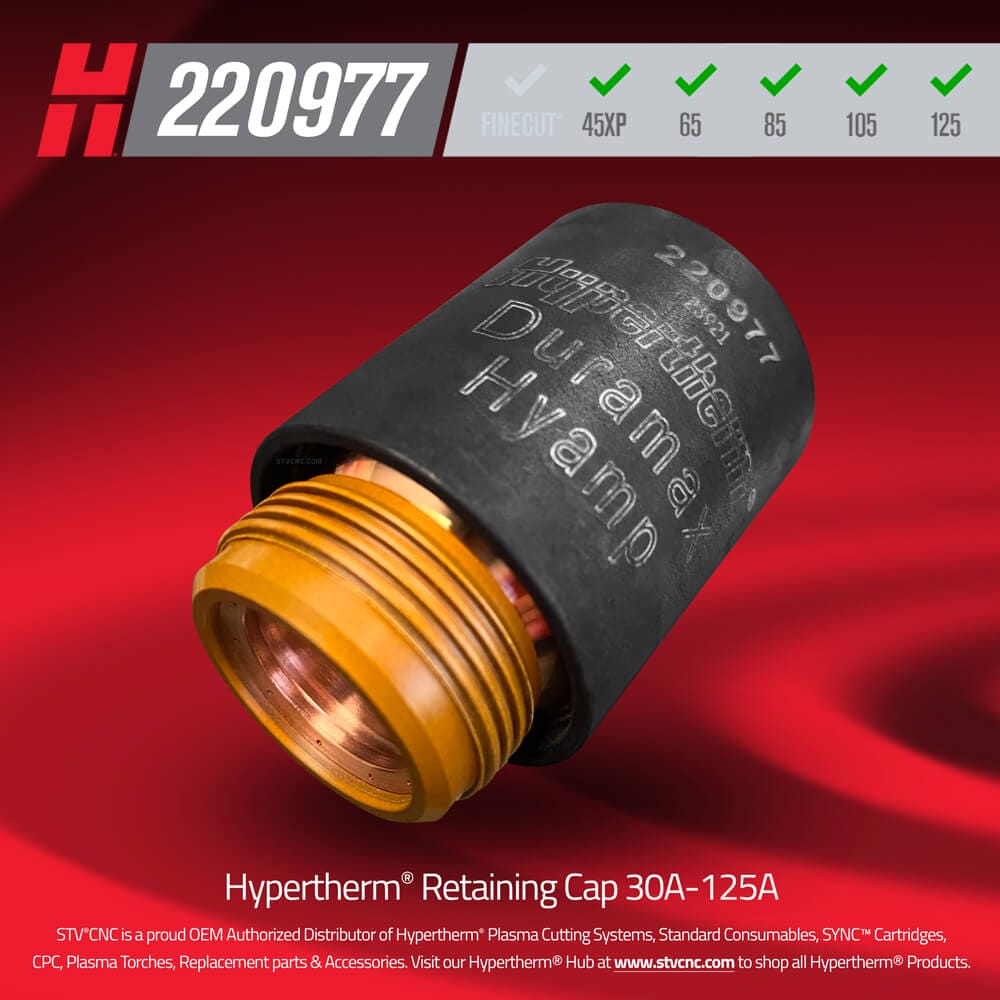
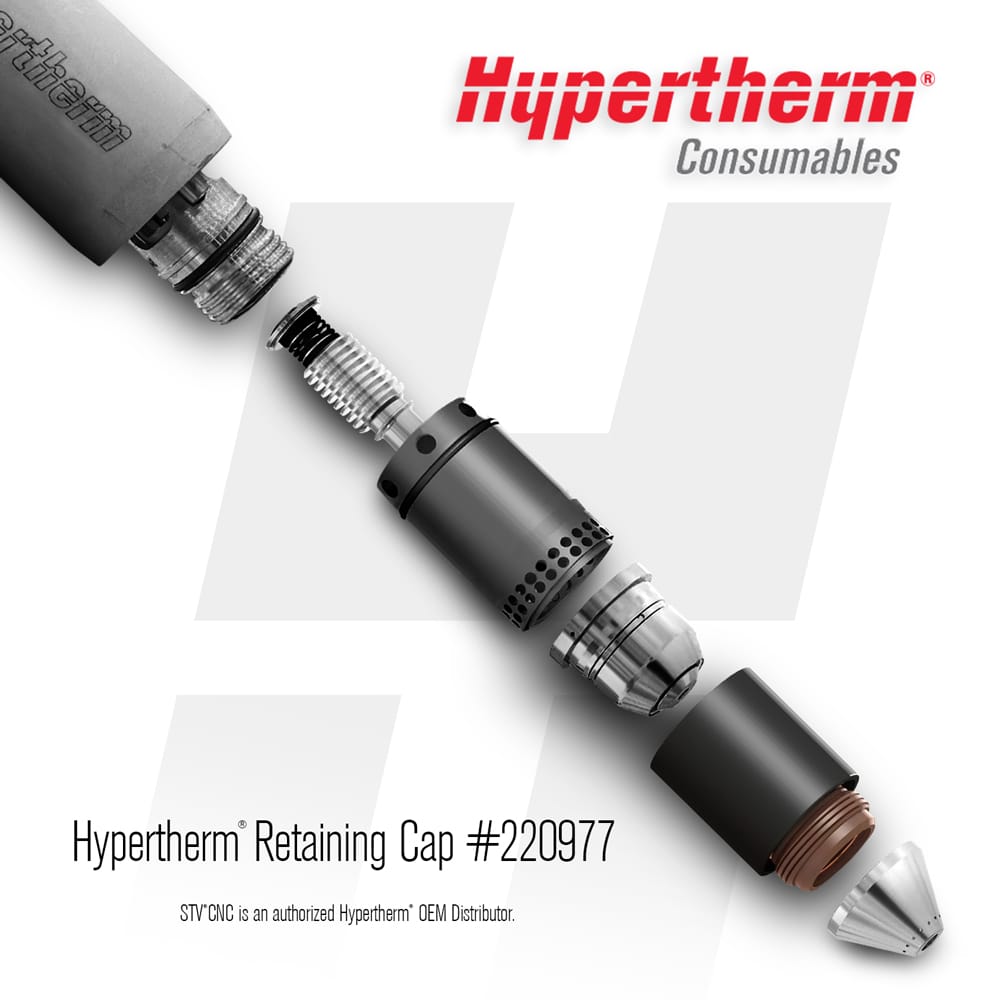
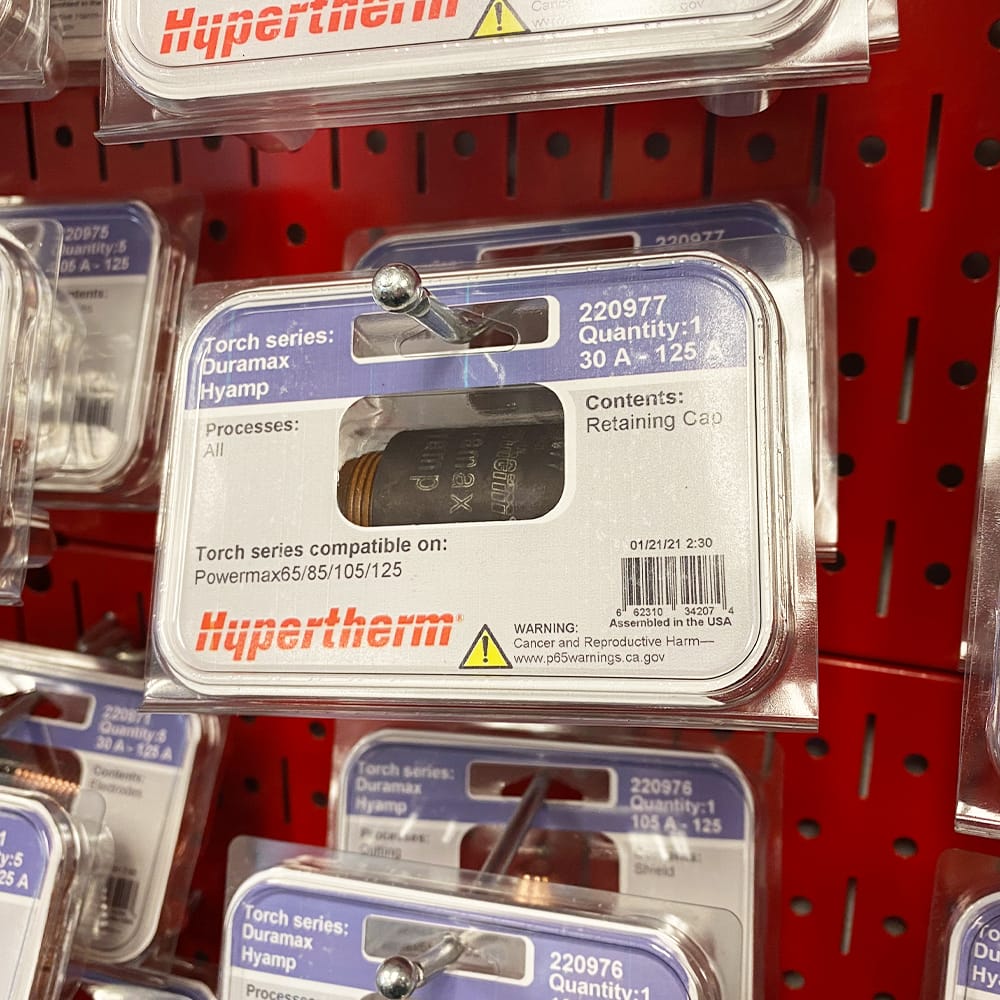
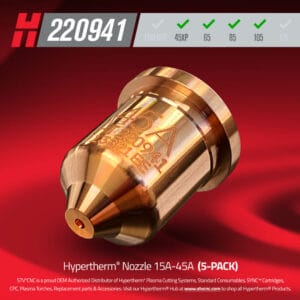
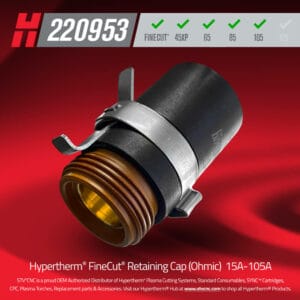
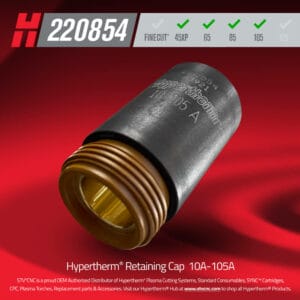
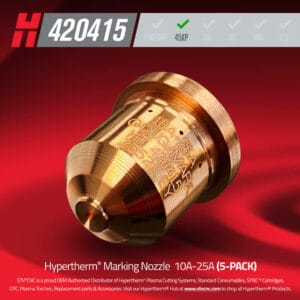
Reviews
There are no reviews yet.